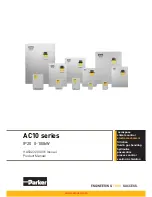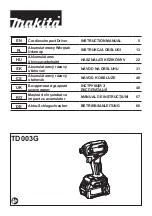
4
5)
Battery tool use and care
a)
Recharge only with the charger specified by the manufacturer
.
A charger that is
suitable for one type of battery pack may create a risk of fire when used with another battery
pack.
b)
Use power tools only with specifically designated battery packs
.
Use of any other
battery packs may create a risk of injury and fire.
c)
When battery pack is not in use, keep it away from other metal objects, like paper lips,
coins, keys, nails, screws or other small metal objects, that can make a connection from
one terminal to another
.
Shorting the battery terminals together
may cause burns or a fire.
d)
Under abusive conditions, liquid may be ejected from the battery; avoid contact. If
contact accidentally occurs, flush with water. If liquid contacts eyes, additionally seek
medical help
.
Liquid ejected from the battery may cause irritation or
burns.
e)
Do not use a battery pack or tool that is damaged or modified.
Damaged or modified
batteries may exhibit unpredictable behaviour resulting in fire, explosion or risk of injury.
f)
Do not expose a battery pack or tool to fire or excessive temperature.
Exposure to fire
or temperature above 130 °C may cause explosion.
NOTE The temperature „130 °C“ can be replaced by the temperature „265 °F“.
g)
Follow all charging instructions and do not charge the battery pack or tool outside
the temperature range specified in the instructions.
Charging improperly or at
temperatures outside the specified range may damage the battery and increase the risk of fire.
6)
Service
a)
Have your power tool serviced by a qualified repair person using only identical
replacement parts.
This will ensure that the safety of the power tool is maintained.
b)
Never service damaged battery packs.
Service of battery packs should only be
performed by the manufacturer or authorized service providers.
Drill safety warning
a) Hold the power tool by insulated gripping surfaces, when performing an operation
where the fastener may contact hidden wiring
.
Fasteners contacting a "live" wire may make
exposed metal parts of the power tool "live" and could give the operator an electric shock.
b)
Apply pressure only in direct line with the bit and do not apply excessive pressure.
Bits can bend causing breakage or loss of control, resulting in personal injury.
Additional instructions
Before screwing into a wall, if in doubt, check with a metal / voltage detector that you are
not going to enter a power supply line, Gas or water.
Before removing the screwdriver, make sure that all moving parts have stopped.
Avoid stalling frequently when screwing as this may damage the batteries.
Load the battery of the screwdriver only with the appropriate charger.
The charger and screwdriver must be protected against moisture!
In order to protect the batteries from damage, never expose them to temperatures above
50 ºC.
Warning: Do not short-circuit the battery or charger





























